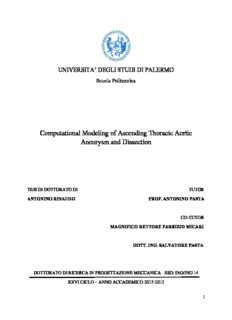Table Of ContentUNIVERSITA’ DEGLI STUDI DI PALERMO
Scuola Politecnica
Computational Modeling of Ascending Thoracic Aortic
Aneurysm and Dissection
TESI DI DOTTORATO DI TUTOR
ANTONINO RINAUDO PROF. ANTONINO PASTA
CO-TUTOR
MAGNIFICO RETTORE FABRIZIO MICARI
DOTT. ING. SALVATORE PASTA
DOTTORATO DI RICERCA IN PROGETTAZIONE MECCANICA SSD: ING/IND 14
XXVI CICLO – ANNO ACCADEMICO 2013-2015
i
ii
Abstract
Cardiovascular diseases account for over 4.3 million of deaths per year in Europe with a 110
billion of Euros as related cost. In particular, aortic aneurysms and especially ascending
thoracic aortic aneurysms, increasing the risk of aortic wall rupture and dissection, are related
to high mortality and comorbidity.
Epidemiologic studies shown that when ascending thoracic aortic aneurysm reaches 6
centimeter in diameter the risk of aortic rupture dramatically increase to 14% per year. Thus,
the criterion adopted in the clinical practice for identification of patients that need a surgical
operation is based on the evaluation of the aortic diameter and its comparison with the
threshold value of 6 centimeter. This criterion is advantageous for its simplicity but has failed
several times, with aneurysm rupture below the indicated threshold value. Indeed, the
necessity of a more accurate and reliable criterion, based on biomechanical analyses, that may
help physician in their decision making process is evident. This criterion should be based on
the synergy of two different approaches (i.e. hemodynamic and genetic). Specifically, the
genetic approach proposes that ascending thoracic aortic dilatation relates to aortic wall
weakness due to developmental defect, while hemodynamic theory points out the importance
of particular flow condition that may lead to excessive loads on aortic wall and thus imparting
a permanent aortic wall dilatation. However, the most reasonable theory is that the synergy of
genetic and hemodynamic predisposing factors may stimulate the development of aortic
permanent dilatation (i.e. aneurysm), rupture or dissection.
Purpose of this work was to study the hemodynamic inside aorta by mean of application of
numerical methods to patient specific aortic geometries with ascending thoracic aortic
aneurysms. Specifically, computational fluid dynamic analyses and fluid-structural analyses
iii
were applied to aortic geometries to collect relevant parameters, such as Wall Shear Stress,
Von Misses Stress and pressure inside aorta, that may play a key role in aortic aneurysm onset
and growth.
Since ascending thoracic aortic aneurysm has a high incidence in patients with bicuspid aortic
valve, in this study computational analyses were applied to assess hemodynamic conditions
in aorta of patients with bicuspid aortic valve and to compare them to those of patients with
normal tricuspid valve. Moreover, a deeper study was executed on the hemodynamic
differences in aortas with bicuspid aortic valve but different valve phenotypes. This study
focused also on the evaluation of hemodynamic in aorta of patients with other pathologies
such as type B aortic dissection and penetrating atherosclerotic ulcer.
iv
v
Contents
Chapter 1
Introduction 1
1.1. Cardiovascular Apparatus Disease 1
1.2. Aorta 2
1.3. Aortic Aneurysm 6
1.3.1. Abdominal aortic aneurysms 7
1.3.2. Thoracic aortic aneurysm 8
1.4. Aortic dissection 10
1.5. Bicuspid aortic valve 12
References 16
Chapter 2
State of the art 19
2.1. Introduction 19
2.2. 4D flow MRI 20
2.3 Computational modeling 21
2.3.1 Fluid structural interaction 23
References 24
Chapter 3
Methodology 26
3.1. Introduction 26
3.2. Fluid structural interaction 27
3.3. Geometry reconstruction 29
3.3.1. Image acquisition: Computer Tomography 30
3.3.2. Image reconstruction: Segmentation and 3D model 31
3.4. Geometry discretization 33
3.5. Computational fluid dynamics analysis 34
vi
3.5.1. CFD preprocessing 34
3.6. Structural model 38
References 41
Chapter 4
FSI application to ATAA study 45
4.1. Introduction 45
4.2. Method 47
4.3. Results 48
4.4. Conclusion 62
References 63
Chapter 5
The role of aortic shape and valve phenotype in aortic pathologies 66
5.1. Introduction 66
5.2. Method 67
5.2.1. Data collection 67
5.2.2. Computational analyses 69
5.2.3. Statistical analyses 72
5.3. Results 73
5.4. Discussion 84
Reference 86
Chapter 6
FSI applied to penetrating ulcer 88
6.1. Introduction 88
6.2. Experimental Procedure 89
6.3. Results 91
6.4. Conclusion 94
Reference 96
vii
Chapter 7
CFD analyses to assess dissected aorta perfusion and predict negative outcome 99
7.1. Introduction 99
7.2. Procedure 100
7.3. CFD analyses 101
7.4. Results 102
7.5. Conclusion 109
Reference 111
Chapter 8
Toward the evaluation of the thoracic aortic stent graft failure risk
related to endograft infolding 114
8.1. Introduction
8.2. Material and Method 115
8.2.1. Phantom and flow circuit 116
8.2.2. Perfusion setting 118
8.2.3. FSI computational modeling 120
8.3. Results 120
8.4. Conclusion 125
Reference 126
Chapter 8
Conclusion 128
viii
Nomenclature
Symbol Description
3D Three-Dimensional
AA Ascending Aorta
AAA Abdominal aortic aneurysm
AC Acutely-Complicated
AE Aneurysm Evolution
AI Aortic insufficiency
AO Aortic Stenosis
AoA Aortic Aneurysm
AoD Aortic Dissection
AOP Aortic Valve Plane
AP Anterior-posterior
ATAA Ascending Thoracic Aortic Aneurysm
BAV Bicuspid Aortic Valve
CFD Computational Fluid Dynamics
CT Computer Tomography
CTA Computed tomography angiography
CVD Cardiovascular disease
CVS Cardiovascular system
ECG Electrocardiogram
FEM Finite Element Method
FL False Lumen
FPI False-lumen Pressure Index
FSI Fluid-Structural Interaction
GCI Grid Convergence Index
ix
HFI Helical Flow Index
LSA Left Subclavian Artery
LV Left Ventricle
MRI Magnetic Resonance Imaging
OSI Oscillatory Shear Index
PAU Penetrating Atherosclerotic Ulcer
PE Protrusion Extension
PISO Pressure-Implicit with Splitting of Operators
PRESTO Pressure Staggering Option
RA Right-Antero
RE Reynolds Number
RL Right-Left
STJ Sino-Tubular Junction
TAA Thoracic Aortic Aneurysm
TAG Thoracic Aortic Stent-Graft
TAV Tricuspid Aortic Valve
TAWSS Time-averaged Wall Shear Stress
TEVAR Thoracic Endovascular Repair
TL True Lumen
UDF User Define Function
UN Uncomplicated
WPS Wall Principal Stress
WSS Wall Shear Stress
x
Description:genetic and hemodynamic predisposing factors may stimulate the development of aortic permanent dilatation (i.e. aneurysm), . Time-averaged Wall Shear Stress. TEVAR. Thoracic Endovascular Repair. TL. True Lumen. UDF. User Define Function. UN. Uncomplicated. WPS. Wall Principal Stress. WSS.

